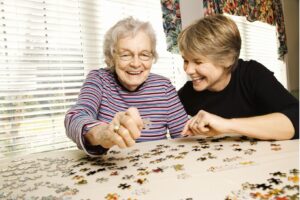Sometimes simple statements, filled with numbers and statistics and the flat, census-based declarations, contain within them an enormous reservoir of pain and suffering and loneliness. That’s probably why we keep them so dry and clinical: to avoid looking at the hurt. Here are a few:
In California, getting older increases the risk of falling below the poverty line. Falling below the poverty line increases the chance of facing hunger on an occasional or regular basis. Put together, this means that in California, a leading cause of hunger and malnutrition is growing older.
While there are numbers to back all that up, we want to focus on the grimness of these facts; it is a terrible truth, but hundreds of thousands of older adults in the state, and around the Bay Area, don’t have enough food and sorely lack proper nutrition. This lowers their quality of lives, worsens their health, and can increase isolation or force someone to no longer be able to age in place. Hunger robs you of many things; stealing the choices and options in front of you is high up there.
Luckily, there are programs to help older adults both learn more about nutrition and receive home-delivered meals if they are eligible, which many are. These services increase the chances of living a life you want and prevent age and poverty from condemning you to a gnawing constant hunger, an onrush of nutrition-based illness, and doors creaking closed one by one.
As a state, we can do better. As individuals, we can do more. It starts with knowing the problems and the programs that aim to solve them.
Poverty, Hunger, and Malnutrition in California
Between 1999 and 2014, the rate of impoverished California residents over the age of 65 increased by a full 85%, skyrocketing to over 520,000 total people. That was more than twice the growth rate of older adults in California as a whole. More people were growing older and poorer than older and comfortable.
However, even those numbers fail to capture the insidious nature of the problem. Poverty targets specific communities with more ferocity than others. While 7% of white older adults in California live below the poverty line, the numbers jump in other ethnic groups:
- Native American: 11%
- Asian: 12%
- African-Americans: 14%
- Hispanics: 16%
There are differences in gender as well. Research shows that 65% of impoverished seniors are women; a full 33% are widows. Over half are renters. And, of course, as we’ve talked at length before, LGBTQ older adults are particularly prone to poverty.
It’s obvious that a lifetime of opportunity, or the lack thereof, matters. Prejudices and attitudes that shaped earning power over a lifetime add up. Sometimes those meet with cataclysms like recessions and are made devastatingly worse. Sometimes that cataclysm runs into even the most charmed life and wrecks it in the blink of an eye. But no matter what, poverty can hit older adults.
And when it does, it brings with it the specter of hunger.
In 2018, 14% of older adults in California faced food insecurity. This is actually down from nearly 18% in 2014 and is not the worst rate in the nation (Arkansas is at a horrifically grim 25%). But that is no need to be smug. We have one of the largest economies in the world. Having “only” one out of seven or eight adults not sure if they will have enough to eat is still a gnashing crime.
The effects of hunger and lack of proper nutrition can be devastating, physically, cognitively, and emotionally. Eating right, on the other hand, can:
- Increase cognitive function
- Promote heart health
- Promote bowel health
- Promote immune health
- Promote musculoskeletal health
The problem is, poverty can make it hard to eat right—or eat at all. For one thing, the incredible housing prices and vast inequality in California (particularly in the Bay Area) means that lower-income adults often live in areas without good grocery options and, sometimes, without public transportation to access to better ones. Money problems also make it harder to buy the fresh produce, lean meats, and whole grains that make up a healthy diet. Health problems can make it more difficult to cook and get to the store. Health problems can also be expensive, increasing financial issues further, and making it more difficult to eat right, which exacerbates health problems. It’s a terrible cycle.
So what can be done? A few programs in California are there to help.
Congregate Nutrition and Homes-Delivered Meals in California
There are several state programs designed to help older adults eat enough, eat healthily, and eat well. The first is Congregate Nutrition.
Congregate Nutrition “addresses dietary inadequacy and social isolation among individuals aged 60 and older” by providing “nutrition education, nutrition risk screening and, in some Planning and Service Areas, nutrition counseling.” It’s clear that for cultural and economic reasons—the most important one being that a lifetime of work and poverty does not give one time to learn to eat well—many lower income older adults don’t know the best ways to eat.
Congregate Nutrition aims to change that by being a source of education. Volunteers often also help with shopping and sometimes even meal prep, though neither are technically part of the program. This program is for people over 60, especially low-income minorities and people in rural areas.
Of course, learning about nutrition often isn’t enough. That’s why seniors in the Bay Area can turn to the Adults with Disabilities Home Delivered Meal Program. The program is made possible with funds through the Department of Aging and Adult Services and is proudly run through Institute on Aging.
Adults with Disabilities Home Delivered Meal Program provides good, healthy meals to older adults who would be at risk without having daily, home-delivered meals. Eligibility for this includes:
- Limited caregiver support
- Inability to get to congregate meal site
- Inability to grocery shop
- Inability to prepare meals
- Inability to consistently secure nutritious meals
- At risk of health decline or institutionalization without consistent nutritious meals
To participate or make a referral, call the Department of Aging and Adult Services (DAAS) Intake and Screening Unit at (415) 355-6700 or Institute on Aging Connect at (415) 750-4111.
(For those not in the Bay Area, there is a similar statewide program. We encourage you to look into programs in your area.)
We ask that participants pay a small fee to help defray costs if at all possible. These are expensive programs, but we don’t need to tell impoverished seniors the cost of food. That’s why, no matter what, no one will ever be turned away due to inability to pay.
To us, the fact that such sentiment isn’t a national motto is a shame. It is a tragedy that so many older adults are hungry every day simply because life didn’t afford them a cushion of wealth on which to retire. Justice demands that a lack of opportunity, denied rights, or just plain bad luck shouldn’t condemn someone to the daily grey misery of food insecurity.
We’re better than that. We can all be better than that. We can help people age at home, with dignity and health, and free from the vision of hunger. We’re called to break bread together. Let’s make sure it happens.
At Institute on Aging, our programs and services help older adults, their families, and caregivers explore aging together, through good times and bad, as an adventure and a journey. Contact us today to learn more.







